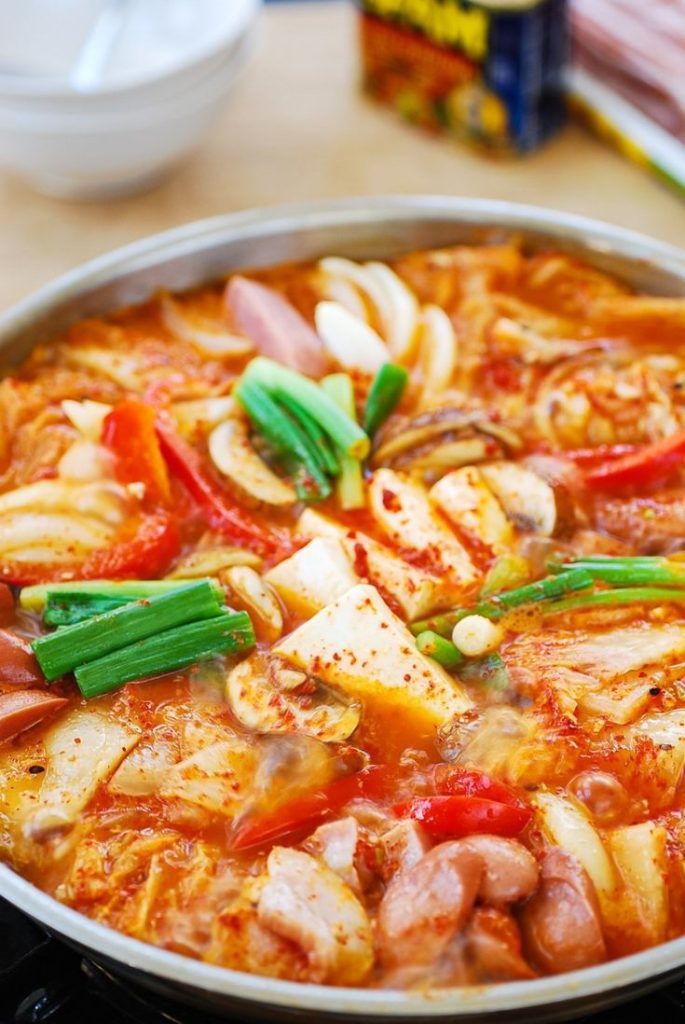Korean Army Stew (Budae Jjigae)
Korean Army Stew, also known as Budae Jjigae, is a beloved Korean stew that has gained popularity for being a customizable dish. This hearty meal is a perfect representation of Korean cuisine, offering a wide range of ingredients that can be tailored to individual preferences. From spicy kimchi to savory sausages, Korean Army Stew showcases the adaptability of flavors and textures, making it a versatile choice for those looking to explore the diverse tastes of Korean cooking.
Historical Background
After the Korean War, South Korea faced severe food scarcity, leading to the creation of Korean Army Stew. This dish showcased the resourcefulness of using food scraps to make a hearty meal. The influence of US ingredients such as spam and American cheese added unique flavors to the stew, reflecting the fusion of Korean and American culinary traditions.
- Korean War aftermath
- Food scarcity challenges
- Resourcefulness in utilizing food scraps
- Incorporation of US ingredients like spam and American cheese

Key Ingredients
Gochujang and Gochugaru
Gochujang and Gochugaru are essential components in Korean cuisine, specifically in making a flavorful stew. These ingredients play a crucial role in providing the stew with the perfect balance of spice, umami, and saltiness:
- Gochujang: Known as Korean chili paste, it adds a spicy kick and depth of flavor to the stew.
- Gochugaru: These Korean chili flakes not only enhance the spiciness but also contribute to the overall rich taste of the dish.
Spam
Spam, a processed pork product, serves as a savory addition to the stew, offering a burst of saltiness that complements the noodles or rice. Here’s how Spam elevates the dish:
- Processed Pork: Spam’s unique flavor blends well with other ingredients, enhancing the overall taste of the stew.
Enoki Mushrooms
Enoki mushrooms are a type of mushroom that brings a unique texture to the stew. Here’s how they add to the dish:
- Flavor Absorption: Enoki mushrooms soak up the flavors of the stew, intensifying the taste.
- Spongy Texture: When cooked, these mushrooms provide a delightful spongy texture that adds depth to each bite.
Tofu
Tofu, a soy product, plays a crucial role in balancing the stew’s richness while imparting a soft and creamy texture. Here’s how tofu contributes to the dish:
- Soft Texture: Tofu adds a smooth and tender element to the stew, making each spoonful satisfying.
- Richness: It helps counterbalance the richness of other ingredients, creating a harmonious blend of flavors.
Hot Dogs
Hot dogs bring a zesty and flavorful twist to the stew, enhancing its overall taste with added saltiness and a meaty essence. Here’s how hot dogs make a difference:
- Saltiness: Hot dogs contribute a savory saltiness that amplifies the flavors in the stew.
- Flavor Enhancement: The distinct taste of hot dogs adds an extra layer of flavor, making each bite more enjoyable.
Are you ready to embark on a delicious culinary adventure? Let’s delve into the savory world of Korean Army Stew, also known as Budae Jjigae. This hearty dish not only satisfies your cravings but also brings families together around the dining table. Join us as we explore the rich cooking experience and communal joy of preparing and savoring Korean Army Stew.

Cooking Experience: A Flavorful Journey
Get ready to immerse yourself in the comforting and communal experience of cooking Korean Army Stew. This dish goes beyond just satisfying your hunger – it caters to your cravings for hearty and flavorful meals. Whether you’re looking for a warm and fulfilling family dining experience or simply a satisfying solo meal, Korean Army Stew has something special to offer. Let’s uncover the secrets behind this iconic dish and discover the joy of preparing it together with your loved ones.
FAQs:
What are the main flavor components of Korean Army Stew?
The main flavor components of Korean Army Stew include spicy kimchi, savory spam, umami-rich gochujang, and hearty ramen noodles.
How did the Korean War influence the creation of Budae Jjigae?
The Korean War led to food scarcity, prompting people to create Budae Jjigae by combining leftover military rations like spam and hot dogs with local ingredients.
Why is spam a popular ingredient in Korean Army Stew?
Spam is a popular ingredient in Korean Army Stew due to its long shelf life, convenience, and the influence of American military presence in Korea.
Can Korean Army Stew be customized to personal preferences?
Yes, Korean Army Stew can be easily customized by adding or omitting ingredients based on personal preferences like adding tofu, mushrooms, or cheese.
What role do hot dogs play in enhancing the flavor of Budae Jjigae?
Hot dogs in Budae Jjigae contribute a salty and savory flavor, complementing the other ingredients like kimchi and instant noodles to create a unique taste.
